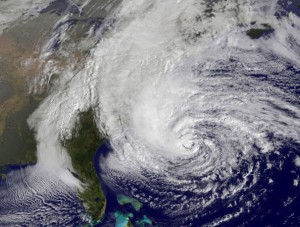Fewer Atlantic Hurricanes Bode Well For An El Niño Winter

Photo by NASA via Getty Images
Hurricane Sandy, pictured, churns off the east coast on October 28, 2012 in the Atlantic Ocean.
There’s a good chance of an El Niño weather pattern forming by the end of the year. That could be good for easing or even ending the Texas drought. But it’s not a sure thing.
For meteorologists to know El Niño has definitely arrived, warmer surface water in the Pacific needs to engage with the atmosphere. So far, that hasn’t happened.
Forecasters, however, are already seeing another sign of El Niño: fewer hurricanes than average in the Atlantic.
“I think we’ve only had five named storms so far [in the Atlantic], about 50 percent of normal,” says Victor Murphy, a meteorologist with the National Weather Service. “Whereas the Eastern Pacific Basin, I think they’re on the “P” storm Polo. I think they’re at about 150 percent of activity in the Pacific.”
The “O” storm, “Odile,” from the Pacific, dropped a sizable amount of rain on parts of Texas just last week.
Some states, like California, were hoping for a “strong” El Niño to dramatically change weather patterns and deliver them from drought. But even a “weaker” pattern could bring a wetter-than-average winter to Texas, says Murphy.
“Even with a weak event, there’s still a pretty strong tilt towards above-normal precipitation for Texas, especially South Texas and Central Texas,” he says. “As you go north, that signal decreases, that correlation between El Niño and precipitation decreases.”
But even a strong El Niño pattern does not guarantee more rain.
“Odds of being wetter and cooler than normal with an El Niño are only about two out of three,” John Neilsen-Gammon told StateImpact Texas earlier this month. “So we’ve got a two out of three chance of [an El Niño] forming. Then [if one forms] we’ve got a two out of three chance of it coming through with the weather we need.”

